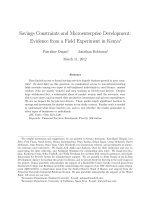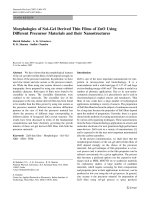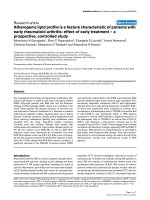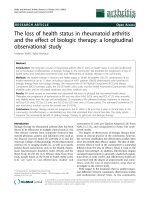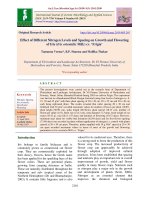Effect of different nitrogen levels and varietal performance on growth and yield of summer pearlmillet
Bạn đang xem bản rút gọn của tài liệu. Xem và tải ngay bản đầy đủ của tài liệu tại đây (213.66 KB, 9 trang )
Int.J.Curr.Microbiol.App.Sci (2017) 6(6): 861-869
International Journal of Current Microbiology and Applied Sciences
ISSN: 2319-7706 Volume 6 Number 6 (2017) pp. 861-869
Journal homepage:
Original Research Article
/>
Effect of Different Nitrogen Levels and Varietal Performance on
Growth and Yield of Summer Pearlmillet
Neha, Gautam Ghosh, Preeti Choudhary and Shobha Kumari
Department of Agronomy, Sam Higginbottom Institute of Agriculture, Technology and Sciences
(Formerly Allahabad Agricultural Institute), (Deemed to-be-University),
Allahabad - 211 007 (U.P), India
*Corresponding author
ABSTRACT
Keywords
Pearlmillet,
Varieties,
Level of nitrogen,
Grain and Fodder
yield.
Article Info
Accepted:
17 May 2017
Available Online:
10 June 2017
A field experiment was conducted during Zaid season, 2015 at the Crop Research Farm,
Department of Agronomy, SHIATS, and Allahabad (U.P.) to conclude the response of
summer pearlmillet (Pennisetum glaucum L.) hybrids to levels of nitrogen. Among the
response of different hybrids to levels of nitrogen, treatment T9 i.e., V3 + 100:45:45 kg ha-1
NPK, recorded maximum plant height (175.30cm), number of tillers plant -1 (3.67), dry
weight (47.73g), crop growth rate (1.53 g m-2 day-1), relative growth rate (0.052 g g-1 day-1),
number of ear plant-1 2.37, length of ear (27.52cm), number of Grains ear -1 (2406.49), test
weight (10.29g), grain yield (3.72 t ha-1), straw yield (6.98 t ha-1), protein content (13.43%)
and harvest index (36.15%). Whereas the lowest value in terms of plant height (164.47cm),
number of tillers (2.60 plant-1), dry weight (40.80g), crop growth rate (1.30 g m-2 day-1),
relative growth rate (0.045 g g-1 day-1), number of ear (1.37 plant-1), grain yield (2.47 t ha-1)
and straw yield (4.62 t ha-1) was observed in the treatment T1 i.e., V1 + 80:45:45 kg ha-1
NPK). Further, ear length of (21.16cm) was observed in the treatment T8 i.e., V3 +
90:45:45 kg ha-1 NPK). In terms of number of grains (2406.49 ear -1), test weight (8.04 g)
was recorded in the treatment T5 i.e., V2 + 90:45:45 kg ha-1 NPK). Further, protein
content (9.48%) was observed in the treatment T5 i.e., V2 + 90:45:45 kg ha-1 NPK) and
harvest index (19.01%) respectively in the treatment T4 i.e., V 2+ 80:45:45 kg ha-1 NPK.
Introduction
and poultry feed (7%), other uses (seed,
bakery products, snacks, etc.) and waste.
Pearlmillet is used in flat breads (roti) or
mixed up to 25% with wheat flour for use in
yeast breads. The genus Pennisetum is
distributed throughout the tropics and
subtropics of the world. It includes about 140
species, one African species P. glaucum (L.)
R. Br. Emend Stuntz was domesticated as the
cereal pearlmillet, and another African
species, P. Purpureum schumach became
widely distributed as a tropical forage grass.
Pearlmillet is the most drought tolerant in all
Pearlmillet [Pennisetum glaucum (L.)] is
largely grown for grain and fodder purpose
under those situations where other crops
generally fail. Pearlmillet as a food crop is
limited to the developing countries in Asia,
and particularly in Africa and ranked sixth in
the world following rice, wheat, corn, barley
and sorghum (Anonymous, 2010-11). The
important pearlmillet growing countries are
India, China, Nigeria, Pakistan, Sudan, Egypt,
Arabia, and Russia. It is estimated that over
95% of pearlmillet production is used as food,
the reminder being divided between animal
861
Int.J.Curr.Microbiol.App.Sci (2017) 6(6): 861-869
domesticated cereals, and soon after its
domestication it became widely distributed
across the semi-arid tropics of Africa and
Asia.
kaveri 1044 and Pioneer 86 M 32) was chosen
for the study.
The experiment was laid out in Randomized
Block Design (RBD) with two factor different
levels of Nitrogen and three improved
Varieties with nine treatments combination on
a plot size of 3 x 3 m2. Before sowing, line
were formed in the field as the spacing in
treatments. Pearlmillet was sown in line and
covered with the soil. Pearlmillet seeds were
hand dibbled. The total quantity of nitrogen,
phosphorus and potassium as per treatment in
the form of Urea (46%), single super
phosphate (16%) and MOP (60%)
respectively were applied below the seeds at
the time of sowing.
Pearlmillet is grown where no other cereal
will yield grain, in regions with 200-800 mm
of annual rainfall. In India, pearlmillet is
popularly known as Bajra, and it is the fourth
most important cereal crop after rice, wheat
and sorghum. It has the greatest potential
among all the millets. Annual planting area of
the country under pearlmillet is 9.5 million
hectares producing nearly 10.1 million tonnes
of grains with productivity of 10.44 q ha-1
(Economic Survey of India, 2011).
The major producing states are Rajasthan
(46%), Maharashtra (19%), Gujarat (11%),
Uttar Pradesh (8%) and Haryana (6%),
(Sonawane et al., 2010). The nutrient content
of pearlmillet compares very well with other
cereals and millets. It has high protein content
with slightly superior amino acid profile.
Pearlmillet grain contains 13-14 per cent
protein, 5-6 per cent fat, 74 per cent
carbohydrate and 1-2 per cent minerals. It
also contains higher amount of carotene,
riboflavin (Vitamin B2) and niacin Vitamin
B4 (Singh et al., 2009).
Two split application are applied, one at basal
and the second application at top dressing. All
the agronomic practices were carried out
uniformly to raised the crop. For taking data
on yield and yield components on pearlmillet
five plants were selected randomly in each
plot.
Results and Discussion
Plant height (cm)
The observations for plant height are being
presented in the table 1. A perusal of this
table reveals that there was a steady increase
in the plant height between the day’s
intervals. The significant influences were
observed in plant height due to different
treatments.
Materials and Methods
Field experiment was conducted during Zaid
season 2015 at Crop Research Farm, Sam
Higginbottom Institute of Agriculture,
Technology and Sciences (Deemed-to-beUniversity) Allahabad.
There was significant difference between the
treatments and maximum plant height (175.30
cm) was observed by the application of T9
i.e., V3 + 100:45:45 kg ha-1 NPK, whereas the
lowest value 164.47 cm was observed in
treatment T1 i.e., V1 + 80:45:45 kg ha-1 NPK.
Further, treatments, T3 i.e., V1 + 100:45:45kg
ha-1 NPK, T6 i.e., V2 + 100:45:45kg ha-1
The soil of the experimental area was sandy
loam with moderately alkaline pH; low in
organic carbon (0.32%) and available N
(188.30 kg ha-1), available P (34.50 kg ha-1)
and available K (87.00 kg ha-1) during zaid
2015
respectively.
A
recommended
pearlmillet variety (Pro Agro 9444, Ganga
862
Int.J.Curr.Microbiol.App.Sci (2017) 6(6): 861-869
NPK, T7 i.e., V 3+ 80:45:45 kg ha-1, T8 i.e.,
V3 + 90:45:45 kg ha-1 NPK, T2 i.e., V1 +
90:45:45 kg ha-1 NPK and T4 i.e., V2+
80:45:45 kg ha-1 NPK were found statistically
at par with T9 i.e., V3 + 100:45:45 kg ha-1
NPK.
While all these parameters were at their
lowest value with no nitrogen application in
foxtail millet (Setaria italica L.) Naik et al.,
(1995) and Basavarajappa et al., (2002)
observed the similar finding in pearlmillet by
AICRP Forage Crops (2006).
The probable reasons for recording higher
stature of growth attributes viz., plant height,
leaf area index, dry matter production and
number of tillers m-2 was observed in
different varieties due to increased levels of
nitrogen with the application of 50 kg N ha-1.
Experimental findings showed that the effect
of nitrogen fertilization (30, 60 and 90 kg ha-1)
on growth and yield of pearlmillet and
observed significant improvement in plant
height, number of green leaves and number of
tillers with 60 and 90 kg nitrogen over 30 kg
ha-1. The results are in conformity with those
of Chaudhari et al., (2002) Singh et al.,
(1991), and Babu et al., (1995).
While all these parameters were at their
lowest value with no nitrogen application in
foxtail millet (Setaria italica L.) Naik et al.,
(1995) and Basavarajappa et al., (2002) were
also observed similar finding in pearlmillet by
AICRP Forage Crops (2006).
Number of ear plant-1
The result revealed that there was significant
difference between the treatments and
maximum ear plant-1 (2.37 plant-1) was
observed by the application of T9 i.e., V3 +
100:45:45 kg ha-1 NPK whereas the lowest
value 1.37 plant-1 was observed in treatment
T1 i.e., V1 + 80:45:45 kg ha-1 NPK. However,
treatment, T3 i.e., V1 + 100:45:45kg ha-1
NPK, T6 i.e., V2 + 100:45:45kg ha-1 NPK
was found statistically at par with T9 i.e., V3
+ 100:45:45 kg ha-1 NPK.
Tillers plant-1
The observations for tillers plant-1 are being
presented in the table 1. Perusal of this table
reveals that there was a steady increase in the
tillers plant-1 at all the day’s intervals. The
significant influences were observed in tillers
plant-1 due to different treatments.
The maximum tillers plant-1 (3.67) was
observed by the application of T9 i.e., V3 +
100:45:45 kg ha-1 NPK, whereas the lowest
value 2.60 was observed in treatment T1 i.e.,
V1 + 80:45:45 kg ha-1 NPK (Table 2).
Length of ear (cm)
The result revealed that there was significant
difference between the treatments and
maximum length of ear (27.52cm) was
obtained in T9 i.e., V3 + 100:45:45 kg ha-1
NPK whereas the lowest value 21.16 cm was
observed in treatment T8 i.e., V3 + 90:45:45
kg ha-1 NPK.
Further, treatments, T3 i.e., V1 + 100:45:45kg
ha-1 NPK was found statistically at par with
T9 i.e., V3 + 100:45:45 kg ha-1 NPK.
The probable reasons for recording higher
stature of growth attributes viz., plant height,
leaf area index, dry matter production and
number of tillers m2 was observed in different
varieties due to increased levels of nitrogen
with the application of 50 kg N ha-1.
863
Int.J.Curr.Microbiol.App.Sci (2017) 6(6): 861-869
Table.1 Response of hybrid and different levels of nitrogen on plant height of pearlmillet at different intervals
Plant height (cm)
Treatment
T1
T2
T3
T4
T5
T6
T7
T8
T9
V1 + 80:45:45 kg ha NPK
V1 + 90:45:45kg ha- 1NPK
V1 + 100:45:45kg ha-1 NPK
V 2+ 80:45:45 kg ha- 1NPK
V2 + 90:45:45 kg ha-1 NPK
V2 + 100:45:45kg ha-1 NPK
V 3+ 80:45:45 kg ha-1 NPK
V3 + 90:45:45 kg ha-1 NPK
V3 + 100:45:45 kg ha-1 NPK
20
DAS
34.80
34.98
39.47
35.27
35.37
38.50
36.23
36.40
46.17
F- test
S. Ed. (±)
C. D. (P = 0.05)
NS
5.343
-
-1
40 DAS
60 DAS
80 DAS
101.67
102.80
109.10
102.97
106.30
108.40
106.27
103.37
110.60
161.70
165.47
168.40
161.80
166.43
167.23
165.30
168.40
169.30
164.47
171.20
173.60
170.43
167.67
172.53
171.53
171.23
175.30
S
2.697
5.718
S
2.285
4.844
S
2.781
5.895
Table.2 Response of hybrid and different levels of nitrogen on tillers plant-1 of pearlmillet at different intervals
Tillers plant-1
Treatment
T1
T2
T3
T4
T5
T6
T7
T8
T9
V1 + 80:45:45 kg ha NPK
V1 + 90:45:45kg ha- 1NPK
V1 + 100:45:45kg ha-1 NPK
V 2+ 80:45:45 kg ha- 1NPK
V2 + 90:45:45 kg ha-1 NPK
V2 + 100:45:45kg ha-1 NPK
V 3+ 80:45:45 kg ha-1 NPK
V3 + 90:45:45 kg ha-1 NPK
V3 + 100:45:45 kg ha-1 NPK
20
DAS
0.60
0.80
1.00
0.67
0.80
0.87
0.67
0.67
1.13
F- test
S. Ed. (±)
C. D. (P = 0.05)
NS
0.239
-
-1
864
40 DAS
60 DAS
80 DAS
1.47
1.87
2.20
1.87
1.93
2.07
1.67
1.80
2.60
2.73
2.87
3.60
2.73
2.87
3.13
2.87
2.93
3.78
2.60
2.73
3.33
2.60
2.87
3.13
2.87
3.13
3.67
S
0.208
0.442
S
0.270
0.574
S
0.245
0.520
Int.J.Curr.Microbiol.App.Sci (2017) 6(6): 861-869
Table.3 Response of hybrid and different levels of nitrogen on Dry weight of pearlmillet at different intervals
Dry weight (g plant-1)
Treatment
T1
T2
T3
T4
T5
T6
T7
T8
T9
-1
V1 + 80:45:45 kg ha NPK
V1 + 90:45:45kg ha- 1NPK
V1 + 100:45:45kg ha-1 NPK
V 2+ 80:45:45 kg ha- 1NPK
V2 + 90:45:45 kg ha-1 NPK
V2 + 100:45:45kg ha-1 NPK
V 3+ 80:45:45 kg ha-1 NPK
V3 + 90:45:45 kg ha-1 NPK
V3 + 100:45:45 kg ha-1 NPK
F- test
S. Ed. (±)
C. D. (P = 0.05)
0.33
0.37
0.44
0.35
0.38
0.39
0.37
0.34
0.45
NS
0.044
-
20
DAS
7.03
7.78
8.52
7.55
7.36
8.22
7.53
7.25
9.03
S
0.424
0.900
40 DAS
60 DAS
16.13
16.54
18.33
16.72
16.93
17.62
16.76
16.69
18.50
40.80
45.37
47.32
42.32
42.15
46.27
42.01
42.57
47.73
S
0.722
1.532
80 DAS
S
1.862
3.948
Table.4 Response of hybrid and different levels of nitrogen on Crop Growth Rate of pearlmillet at different intervals
Treatment
T1
T2
T3
T4
T5
T6
T7
T8
T9
V1 + 80:45:45 kg ha-1 NPK
V1 + 90:45:45kg ha- 1NPK
V1 + 100:45:45kg ha-1 NPK
V 2+ 80:45:45 kg ha- 1NPK
V2 + 90:45:45 kg ha-1 NPK
V2 + 100:45:45kg ha-1 NPK
V 3+ 80:45:45 kg ha-1 NPK
V3 + 90:45:45 kg ha-1 NPK
V3 + 100:45:45 kg ha-1 NPK
F- test
S. Ed. (±)
C. D. (P = 0.05)
0.016
0.018
0.021
0.017
0.018
0.019
0.018
0.016
0.022
NS
0.002
-
865
Crop Growth Rate (g m-2 day-1)
0-20
20-40
40-60
60-80
DAS
DAS
DAS
DAS
0.34
0.44
1.30
0.33
0.44
1.36
0.40
0.51
1.42
0.37
0.43
1.37
0.36
0.46
1.38
0.37
0.50
1.39
0.35
0.45
1.30
0.34
0.39
1.37
0.40
0.53
1.53
S
0.021
0.045
NS
0.06
-
NS
0.114
-
Int.J.Curr.Microbiol.App.Sci (2017) 6(6): 861-869
Table.5 Response of hybrid and different levels of nitrogen on Relative Growth Rate of pearlmillet at different intervals
Relative Growth Rate (g g-1 day-1)
0-20
20-40
40-60
60-80
DAS
DAS
DAS
DAS
0.05
0.15
0.035
0.045
0.04
0.15
0.037
0.047
0.04
0.16
0.044
0.048
0.05
0.15
0.035
0.047
0.03
0.14
0.039
0.047
0.04
0.15
0.043
0.047
0.03
0.15
0.039
0.046
0.05
0.15
0.032
0.047
0.05
0.16
0.045
0.052
Treatment
T1
T2
T3
T4
T5
T6
T7
T8
T9
V1 + 80:45:45 kg ha-1 NPK
V1 + 90:45:45kg ha- 1NPK
V1 + 100:45:45kg ha-1 NPK
V 2+ 80:45:45 kg ha- 1NPK
V2 + 90:45:45 kg ha-1 NPK
V2 + 100:45:45kg ha-1 NPK
V 3+ 80:45:45 kg ha-1 NPK
V3 + 90:45:45 kg ha-1 NPK
V3 + 100:45:45 kg ha-1 NPK
F- test
S. Ed. (±)
C. D. (P = 0.05)
NS
0.007
-
S
0.005
0.011
NS
0.004
-
NS
0.002
-
Table.6 Response of hybrid and different levels of nitrogen on protein content of pearlmillet
Protein content
(%)
Treatment
T1
T2
T3
T4
T5
T6
T7
T8
T9
V1 + 80:45:45 kg ha-1 NPK
V1 + 90:45:45kg ha- 1NPK
V1 + 100:45:45kg ha-1 NPK
V 2+ 80:45:45 kg ha- 1NPK
V2 + 90:45:45 kg ha-1 NPK
V2 + 100:45:45kg ha-1 NPK
V 3+ 80:45:45 kg ha-1 NPK
V3 + 90:45:45 kg ha-1 NPK
V3 + 100:45:45 kg ha-1 NPK
F-test
S. Ed. (±)
C. D. (P = 0.05)
866
9.75
11.43
12.78
11.16
9.48
12.10
10.78
10.02
13.43
S
0.001
0.003
Int.J.Curr.Microbiol.App.Sci (2017) 6(6): 861-869
Table.7 Response of hybrid and different levels of nitrogen on yield and yield attributes of pearlmillet
Treatment
T1
V1 + 80:45:45 kg ha-1 NPK
1.37
22.77
2132.73
8.68
Grain
yield
(t ha1
)
2.47
T2
V1 + 90:45:45kg ha- 1NPK
1.74
21.43
2062.00
8.25
2.78
5.33
23.03
NPK
2.03
24.62
2256.26
9.23
3.14
6.45
25.01
T4
V 2+ 80:45:45 kg ha- 1NPK
1.69
22.94
1963.00
8.12
2.76
5.05
19.01
T5
V2 + 90:45:45 kg ha-1 NPK
1.44
22.28
1928.88
8.04
2.47
4.95
20.00
2.01
24.06
2166.92
9.18
3.02
6.26
23.68
1.63
22.44
2070.67
8.39
2.53
5.93
21.37
1.74
21.16
2138.80
8.81
3.01
5.44
22.85
2.37
27.52
2406.49
10.29
3.72
6.98
25.07
S
0.589
1.249
S
0.350
0.743
S
0.608
1.290
S
1.790
3.795
T3
T6
T7
T8
T9
Ear
Plant-1
Length
of Ear
No of
Test
Grains per weight
Ear
(gm)
Stover
yield
(t ha-1)
Harvest
index (%)
4.62
19.64
V1 + 100:45:45kg ha-1
V2 + 100:45:45kg ha-1
NPK
V 3+ 80:45:45 kg ha-1 NPK
-1
V3 + 90:45:45 kg ha NPK
V3 + 100:45:45 kg ha-1
NPK
F-test
S. Ed. (±)
C. D. (P = 0.05)
S
0.229
0.486
S
1.08
2.289
S
84.91
180.02
867
Int.J.Curr.Microbiol.App.Sci (2017) 6(6): 861-869
maximum straw yield (6.98 t ha-1) was
observed by the application in T9 i.e., V3 +
100:45:45 kg ha-1 NPK, whereas the lowest
value 4.62 t ha-1 was observed in treatment T1
i.e., V1 + 80:45:45 kg ha-1 NPK. However,
treatment, T3 i.e., V1 + 100:45:45kg ha-1
NPK, T6 i.e., V2 + 100:45:45kg ha-1 NPK
was found statistically at par with T9 i.e., V3
+ 100:45:45 kg ha-1 NPK.
Number of grains ear-1
The result revealed that there was significant
difference between the treatments and
maximum number of grains (2406.49 ear-1)
was observed by the application ofV3 +
100:45:45 kg ha-1 NPK i.e., T9, whereas the
lowest value 1928.88 ear-1 was observed in
treatment T5 i.e., V2 + 90:45:45 kg ha-1 NPK.
However, treatment, T3 i.e., V1 +
100:45:45kg ha-1 NPK, was found statistically
at par with T9 i.e., V3 + 100:45:45 kg ha-1
NPK.
Harvest index (%)
The result revealed that there was significant
difference between the treatments and
maximum harvest index (25.07%) was
observed by the application in T9 i.e., V3 +
100:45:45 kg ha-1 NPK, whereas the lowest
value 19.01% in T4 i.e., V 2+ 80:45:45 kg ha1NPK N1. However, treatment, T3 i.e., V1 +
100:45:45kg ha-1 NPK, T6 i.e., V2 +
100:45:45kg ha-1 NPK, T2 i.e., V1 +
90:45:45kg ha- 1NPK, T8 i.e., V3 + 90:45:45
kg ha-1 NPK and T7 i.e., V 3+ 80:45:45 kg ha1
NPK was found statistically at par with T9
i.e., V3 + 100:45:45 kg ha-1 NPK. Saini and
Negi (1996), Munirathnam et al., (2006),
observed that the highest harvest index was
recorded in different varieties due to
increased levels of nitrogen with 25 kg N ha-1
which was however, comparable with no
nitrogen application in foxtail millet (Setaria
italica L.). The probable reasons for recording
significantly increase in grain and straw
yields were observed with increase in
nitrogen levels from 0 to 50 kg N ha-1. The
lowest grain and straw yields were recorded
with no nitrogen application in foxtail millet
(Setaria italica L.) Saini and Negi (1996),
Munirathnam et al., (2006) (Table 7).
Test weight (g)
The result revealed that there was significant
difference between the treatments and
maximum test weight (10.29 g) was observed
by the application of T9 i.e., V3 + 100:45:45
kg ha-1 NPK. Whereas the lowest value 8.04 g
was observed in treatment T5 i.e., V2 +
90:45:45 kg ha-1 NPK. However, treatment,
T3 i.e., V1 + 100:45:45kg ha-1 NPK, T6 i.e.,
V2 + 100:45:45kg ha-1 NPK was found
statistically at par with T9 i.e., V3 +
100:45:45 kg ha-1 NPK.
Grain yield (t ha-1)
The result revealed that there was significant
difference between different treatments and
maximum grain yield (3.72 t ha-1) was
observed by the application in T9 i.e., V3 +
100:45:45 kg ha-1 NPK, whereas the lowest
value 2.47 t ha-1 was observed in treatment T5
i.e., V2 + 90:45:45 kg ha-1 NPK and T1 i.e.,
V1 + 80:45:45 kg ha-1 NPK. However,
treatment, T3 i.e., V1 + 100:45:45kg ha-1
NPK, T6 i.e., V2 + 100:45:45kg ha-1 NPK
was found statistically at par with T9 i.e., V3
+ 100:45:45 kg ha-1 NPK.
Among the response of different hybrids to
levels of nitrogen, treatment T9 i.e., V3 +
100:45:45 kg ha-1 NPK, recorded maximum
plant height (175.30cm), number of tillers
plant-1 (3.67), dry weight (47.73g), crop
growth rate (1.53 g m-2 day-1), relative
growth rate (0.052 g g-1 day-1), number of ear
Straw yield (t ha-1)
The result revealed that there was significant
difference between different treatments and
868
Int.J.Curr.Microbiol.App.Sci (2017) 6(6): 861-869
plant-1 2.37, length of ear (27.52cm), number
of Grains ear-1 (2406.49), test weight
(10.29g), grain yield (3.72 t ha-1), straw yield
(6.98 t ha-1), protein content (13.43%) and
harvest index (36.15%). Whereas the lowest
value in terms of plant height (164.47cm),
number of tillers (2.60 plant-1), dry weight
(40.80g) (Table 3), crop growth rate (1.30 g
m-2 day-1) (Table 4), relative growth rate
(0.045 g g-1 day-1) (Table 5), number of ear
(1.37 plant-1), grain yield (2.47 t ha-1) and
straw yield (4.62 t ha-1) was observed in the
treatment T1 i.e., V1 + 80:45:45 kg ha-1
NPK). Further, ear length of (21.16cm) was
observed in the treatment T8 i.e., V3 +
90:45:45 kg ha-1 NPK). In terms of number of
grains (2406.49 ear-1), test weight (8.04 g)
was recorded in the treatment T5 i.e., V2 +
90:45:45 kg ha-1 NPK). Further, protein
content (9.48%) (Table 6) was observed in the
treatment T5 i.e., V2 + 90:45:45 kg ha-1 NPK)
and harvest index (19.01%) respectively in
the treatment T4 i.e., V 2+ 80:45:45 kg ha-1
NPK).
(Pennisetum glaucum L.) Forage Res., 20:
225 – 231.
Basavarajappa, et al. 2002. Response of
safflower to bio-fertilizers with nitrogen
levels on growth and seed yield.
Chaudhari, A.C., Meena, N.L. and Jat, R.L.
2002. Effect of nitrogen and moisture
conservation practices on growth and
yield of rainfed pearlmillet. Annals Agri.
Res., 23(2): 223-225.
Munirathnam, P., Reddy, A., Sambasiva and
Sawadhkar, S.M. 2006. Evaluation of
foxtail millet varieties under low fertility
conditions. Agri. Sci. Digest, 26(3): 197199.
Naik, B., Linge Gowda, T.B.K., Thimme
Gowda, S. and Sridhara, S. 1995. Effect of
integrated nutrient management on growth
and grain yield of foxtail millet (Setaria
italica L. Beauv.) under rainfed conditions
on Alfisols of sub-tropical India. Fertilizer
News, 40(3): 55-57.
Saini, J.P. and Negi, S.C. 1996. Response of
foxtail millet (Setaria italica) genotypes to
nitrogen fertilization under dry-temperate
conditions. Indian J. Agron., 41(2): 261264.
Singh, J., Randhawa, N.S. and Sidhu, M.S.
1991. Uptake of nitrogen and optimum
levels for different genotypes of pearl
millet. J. Res. PAU, Ludhiana, 28: 174178.
Sonawane, P.D., Wadile, S.C., Girase, P.P.,
Chitodkar, S.S. and Sonawane, D.A. 2010.
Response
of
summer
pearlmillet
(Pennisetum glauchum L.) to depth and
time of irrigation. Scheduling. Int. J. Agri.
Sci., 6(1): 283-285.
References
AICRP-Forage Crops, 2006. Effect of
nitrogenlevels on promising entries of
pearlmillet. All India Co-ordinated
Research Project on forage crops. IGFRI
Jhansi, Annual Report Kharif- 2005: 161177.
Anonymous. 2010-2011. Annual Report All
India
Co-ordinated
Pearlmillet
Improvement Project pp.141-142.
Babu, R.S., Patil, G.T.S. and Prabhakar, A.S.
1995. Effect of stage of cutting, nitrogen
and phosphorus level on forage pearlmillet
How to cite this article:
Neha, Gautam Ghosh, Preeti Choudhary and Shobha Kumari. 2017. Effect of Different
Nitrogen Levels and Varietal Performance on Growth and Yield of Summer Pearlmillet.
Int.J.Curr.Microbiol.App.Sci. 6(6): 861-869. doi: />
869
